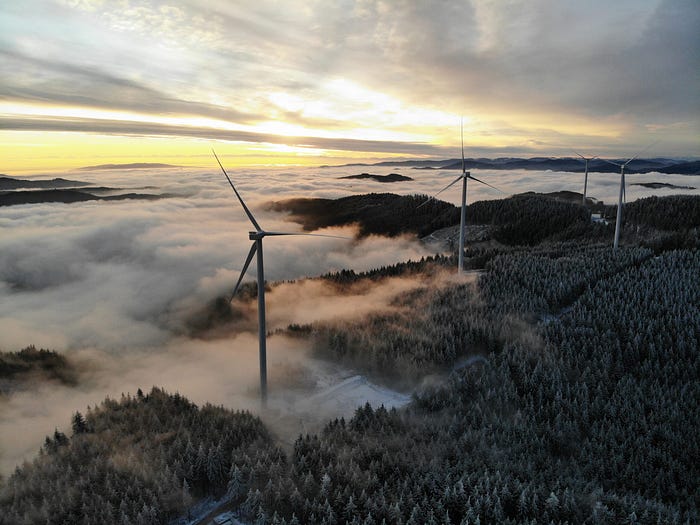Wind and Earthquake Effects on Wind Turbine Foundation Design

Wind turbines stand as iconic symbols of the transition to renewable energy sources, and their efficient operation hinges on well-designed foundations. Within this realm, the effects of wind and earthquakes play crucial roles, necessitating meticulous engineering and analysis. As we delve into the intricacies of wind turbine foundation design, it’s imperative to also consider the evolving landscape of wind power plants in Europe.
Wind Effects on Wind Turbine Foundation Design
Wind is a fundamental driver of energy production in wind turbines, but it also presents significant challenges to the structural integrity of wind turbine foundations. Understanding the complex interaction between the turbine’s components and the force of the wind is essential in designing foundations that can withstand these effects.

Lateral Loads and Bending Moments
Wind creates lateral loads on wind turbine structures due to the pressure exerted on the tower and blades. These lateral loads induce bending moments and shear stresses in the foundation. The base of the tower, where it connects to the foundation, is particularly susceptible to these forces. Designing the foundation to counteract these lateral loads is critical to preventing excessive deformation and maintaining stability.
Torsional Loads
Turbulence in the wind can lead to torsional forces on the wind turbine structure. Torsion occurs when different parts of the structure experience varying wind speeds and angles simultaneously. This twisting effect places additional stress on the foundation and the tower. Proper foundation design considers these torsional loads to ensure that the structure remains balanced and aligned.
Foundation Design Strategies for Wind Effects
To address the challenges posed by wind effects, engineers employ specific design strategies:
- Deep Foundations: Wind turbine foundations often incorporate deep foundation elements, such as piles or drilled shafts. These extend deep into the ground to provide enhanced stability against lateral movement caused by wind-induced loads.
- Anchor Bolts: Anchor bolts connect the tower structure to the foundation. These bolts are strategically placed to transmit the wind-induced forces effectively and minimize the potential for twisting or torsion.
- Structural Rigidity: The foundation’s structural rigidity is crucial. A well-designed foundation resists bending and deformation, ensuring that the wind-induced forces are distributed efficiently across the structure.
Computer-Aided Wind Load Analysis
Advanced engineering software tools are used to analyze the wind effects on wind turbine foundations. These tools utilize wind tunnel data and computational fluid dynamics (CFD) simulations to predict the distribution of wind loads on the turbine’s components. Engineers can then apply these loads to the foundation model to determine its response to various wind conditions.
Wind Load Codes and Standards
Design codes and standards, such as the IEC 61400–2 standard, provide guidelines for calculating wind loads on wind turbine structures. This standard outlines methods for determining wind loads based on wind speed, direction, and turbulence. Engineers use these standards to ensure that wind turbine foundations are designed to withstand the forces exerted by varying wind conditions.
Earthquake Effects and Seismic Considerations
In regions prone to seismic activity, such as earthquake-prone zones, wind turbine foundation design takes on an added layer of complexity. The ground vibrations and forces generated during an earthquake pose unique challenges that must be carefully addressed to ensure the safety and stability of the entire wind turbine structure.

Understanding Ground Motion
Earthquakes produce seismic waves that propagate through the ground, leading to ground motion. This ground motion can be characterized by its amplitude (the extent of movement) and frequency (the rate at which the ground oscillates). These factors play a critical role in determining how the foundation will respond to the earthquake forces.
Soil Properties
The properties of the soil beneath the wind turbine foundation significantly influence its behavior during an earthquake. Different soil types, such as clay, sand, or rock, have varying characteristics that affect how they transmit seismic forces. Soft soils can amplify ground motion, leading to higher accelerations, while stiffer soils can mitigate the impact of the seismic waves.
Foundation Response
During an earthquake, the wind turbine foundation experiences dynamic loads that vary in magnitude and direction. These loads induce vibrations and forces that can potentially compromise the structural integrity of the foundation and the entire wind turbine.
Base Isolation Techniques
To counteract the effects of ground motion, engineers often employ base isolation techniques in wind turbine foundation design. Base isolation involves inserting isolators between the foundation and the ground. These isolators act as shock absorbers, decoupling the foundation from the ground’s motion and reducing the transmission of seismic forces to the structure above.
By allowing controlled movement of the foundation relative to the ground, base isolation mitigates the impact of the earthquake on the wind turbine. This technique not only enhances the safety of the structure but also reduces the potential for damage during seismic events.
Reinforcement and Structural Integrity
Reinforcing the wind turbine foundation with materials like rebar or steel mesh enhances its ability to withstand seismic forces. These reinforcements increase the foundation’s ductility and resilience, enabling it to absorb and dissipate the energy generated by the earthquake without undergoing excessive deformation or failure.
Advanced Analysis Methods
In the design process, engineers employ advanced analysis methods and software to simulate the behavior of wind turbine foundations during seismic events. Finite element analysis (FEA) is commonly used to model the dynamic response of the foundation to different levels of ground motion. This analysis helps engineers optimize the design parameters to ensure the foundation’s performance under varying earthquake scenarios.
Design Codes and Standards
In the realm of wind turbine foundation design, adherence to established design codes and standards is paramount. These codes provide engineers with guidelines, specifications, and best practices to ensure that wind turbine foundations are designed to withstand various environmental forces, including earthquakes.
IEC 61400–6: Design Requirements for Wind Turbine Structures
The IEC 61400–6 standard is an internationally recognized document that outlines the design requirements for wind turbine structures, taking into account various factors, including wind and seismic effects. This standard provides a comprehensive framework that engineers follow to create structurally sound and safe wind turbine foundations.

In regions prone to earthquakes, the IEC 61400–6 standard addresses seismic considerations by providing guidance on how to analyze and design wind turbine foundations to withstand seismic forces. It specifies methods for evaluating the dynamic response of the foundation under different earthquake scenarios and emphasizes the importance of ensuring the safety of the entire wind turbine system.
ASCE 7: Wind and Seismic Load Calculations
The American Society of Civil Engineers (ASCE) publishes the ASCE 7 standard, which provides guidelines for calculating wind and seismic loads on various structures, including wind turbine foundations. This standard is widely used not only in the United States but also serves as a reference in many parts of the world.

ASCE 7 outlines methods for determining wind loads due to various wind speeds and profiles. Additionally, it offers procedures for calculating seismic loads based on the seismicity of the region. Engineers rely on ASCE 7 to accurately assess the forces acting on wind turbine foundations and ensure their integrity under different environmental conditions.
Region-Specific Standards
In addition to international and national standards, many regions have their own specific codes and guidelines tailored to local conditions. For example, countries located along active fault lines may have additional seismic design criteria that go beyond the general standards.
These region-specific standards take into account the local seismic hazard, soil conditions, and other geographical factors that influence the behavior of wind turbine foundations during earthquakes. Engineers designing wind turbine foundations in these areas must familiarize themselves with both general standards and any specific codes that apply to their region.
Analysis Programs for Wind Turbine Foundation Design
The design of wind turbine foundations is a complex task that requires sophisticated analysis to ensure structural integrity and safety. Engineers rely on advanced software programs to simulate the behavior of foundations under the influence of wind and earthquake forces. These programs provide insights into how the foundation will respond to dynamic loads and help optimize its design for maximum efficiency and resilience.
STAAD.Pro
STAAD.Pro is a widely used structural analysis and design software developed by Bentley Systems. This powerful tool enables engineers to perform comprehensive analyses on various types of structures, including wind turbine foundations. It offers capabilities for modeling, analysis, and design optimization.
Wind Load Analysis
In wind turbine foundation design, engineers use STAAD.Pro to simulate wind load effects on the structure. The software allows for the creation of accurate models that consider the aerodynamic forces exerted on the turbine components. These forces are then applied to the foundation to assess its response to wind-induced loads.
Seismic Analysis
For earthquake considerations, STAAD.Pro is employed to perform seismic analysis on the foundation. Engineers input seismic loads based on the region’s seismic hazard and soil properties. The software simulates the dynamic response of the foundation under various seismic scenarios, helping to ensure its stability during earthquakes.
ANSYS
ANSYS is a widely recognized simulation software suite that encompasses various engineering disciplines, including structural analysis. This tool is employed for in-depth analysis and optimization of wind turbine foundations.
Dynamic Analysis
Engineers use ANSYS to conduct dynamic analysis, which involves simulating the response of the foundation to time-varying loads like those generated by wind and seismic events. This analysis helps predict how the foundation will behave under different dynamic conditions, allowing for the refinement of design parameters.
Nonlinear Analysis
Foundation responses under extreme conditions, such as those experienced during earthquakes, can be nonlinear. ANSYS is equipped to handle nonlinear analysis, enabling engineers to accurately model the behavior of the foundation even when it undergoes significant deformation.
Other Specialized Software
Apart from STAAD.Pro and ANSYS, other specialized software tools are available for wind turbine foundation design. These tools often cater to specific aspects of the analysis process, such as dynamic response, soil-structure interaction, and seismic assessment.
The Future of Wind Power Plants in Europe
As Europe continues its pursuit of sustainable energy, wind power plays a pivotal role. Wind power capacity is expected to witness substantial growth, driven by technological advancements, favorable policies, and increased public awareness. Offshore wind farms, in particular, are becoming increasingly prominent, harnessing the consistent and potent winds over the seas. These developments underscore the importance of robust foundation design that can withstand both natural forces and the demands of a rapidly expanding energy sector.

Conclusion
Wind turbine foundation design melds the tenets of engineering with nature’s forces. Wind and earthquake effects propel engineers to employ meticulous methodologies, advanced analysis tools, and adherence to industry standards. In this symbiotic dance between human ingenuity and environmental dynamics, we forge a path to resilient wind turbines, capable of converting renewable energy while facing the challenges posed by wind and seismic events.
As Europe’s wind power landscape evolves, we stand witness to a future where these majestic structures dot the horizon, contributing substantially to cleaner energy and a more sustainable planet. This journey underscores the vital role that wind turbine foundation design plays in this pivotal transition.
